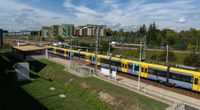On April 14, 2025, the Polish Ministry of Finance announced a significant step in the country’s railway modernization efforts, issuing treasury bonds valued at 1.214 billion PLN (approximately $300 million) to PKP Polskie Linie Kolejowe (PKP PLK). This funding is earmarked for co-financing the ambitious Kolej Plus Program, which is set to enhance the railway network across Poland by 2029.
The bonds are divided into four series: OK0127 (182.1 million PLN), PS0130 (424.9 million PLN), WZ0330 (364.2 million PLN), and DS1034 (242.8 million PLN). This infusion of capital is crucial for advancing long-term investment projects aimed at modernizing and reactivating around 1,300 kilometers of railway lines, facilitating better connectivity for regions lacking adequate transport options.
The Kolej Plus Program, with a total budget of 13.3 billion PLN, aims to supplement the railway network by creating connections to towns with populations exceeding 10,000 residents. This initiative is particularly focused on local governments and metropolitan associations interested in developing railway infrastructure in their areas. Approximately 11.2 billion PLN of the program’s funding will come from the state budget, with around 2 billion PLN contributed by local government units.
Since the inception of the Kolej Plus Program, PKP PLK has made substantial progress. By the end of 2023, the company had announced 31 tender procedures valued at approximately 11.6 billion PLN. This includes contracts for project documentation and construction work, reflecting a robust commitment to enhancing Poland's rail infrastructure.
Karol Trammer, an expert from the monthly magazine "Ostrego Cięcia," pointed out the paradox of the program's ambitious goals versus the pace of project execution. He noted that while the program aims to fill gaps in the railway network, some initiatives, such as the Leszno–Głogów line, could have been expedited with better collaboration with local authorities.
Despite these challenges, optimism remains high among PKP PLK officials. Marcin Mochocki announced plans to issue tenders worth between 15 and 20 billion PLN this year, which would include the company’s largest tender for the Rail Baltica project, a key railway initiative connecting Poland with the Baltic states.
However, the financial landscape presents challenges. Economists like Jacek Prześluga have raised concerns about the increasing debt levels of PKP PLK, which reported an operational deficit exceeding 2 billion PLN last year. This growing debt could hinder the company’s ability to maintain financial stability as it continues to expand its obligations.
For passengers, the benefits of the Kolej Plus Program could be significant. A total of 48 new regional connections are planned by the end of the decade, which will serve cities with populations greater than 10,000 and improve access to provincial centers. The modernization of railway lines is expected to reduce travel times by as much as 40 percent on certain routes, such as between Gdynia and Słupsk.
These investments are also anticipated to have a positive economic impact on local communities. According to analyses conducted by PKP PLK, every zloty spent on these projects generates over three times the return for the local economy, driven by growth in tourism and logistics services. Interestingly, local governments are expected to cover about 15 percent of the investment costs, prompting them to seek efficiencies within their budgets.
However, the program has not been without its controversies. The reconstruction of the Warszawa Wschodnia station, priced at over 3 billion PLN, has raised questions regarding the efficacy of expenditures in light of potentially cheaper alternatives.
The current bond issuance is part of a broader cycle of investment that began in Poland in 2022. Over the past three years, PKP PLK has raised more than 6.25 billion PLN through various treasury bond issues, including 1.2 billion PLN in March 2023, 1.3 billion PLN in June 2024, and a record 2.54 billion PLN in September 2024. This surge in funding reflects the growing needs of the railway sector and an increase in infrastructure spending, which has nearly doubled from approximately 8.7 billion PLN in 2020 to nearly 19.4 billion PLN projected for this year.
Historically, the first bond issues by PKP PLK occurred in previous years, including 2013, but the current scale of operations is significantly larger and better coordinated with local governments and the National Reconstruction Plan.
Ultimately, the investments financed by these bonds are foundational for building a modern, sustainable railway infrastructure that meets the demands of the 21st century. The Kolej Plus Program holds the potential to transform regional and local transport by improving accessibility and supporting economic development in many areas of Poland. However, the success of this initiative will hinge on effective financial management and the successful execution of numerous investment projects amid rising debt levels.
For passengers, this translates to a chance for more comfortable and quicker journeys, provided that the ambitious plans translate into tangible benefits. As developments unfold, it will be essential to monitor the progress of the Kolej Plus Program and engage in discussions about the future of Polish railways as a critical component of the country’s public transport system.


